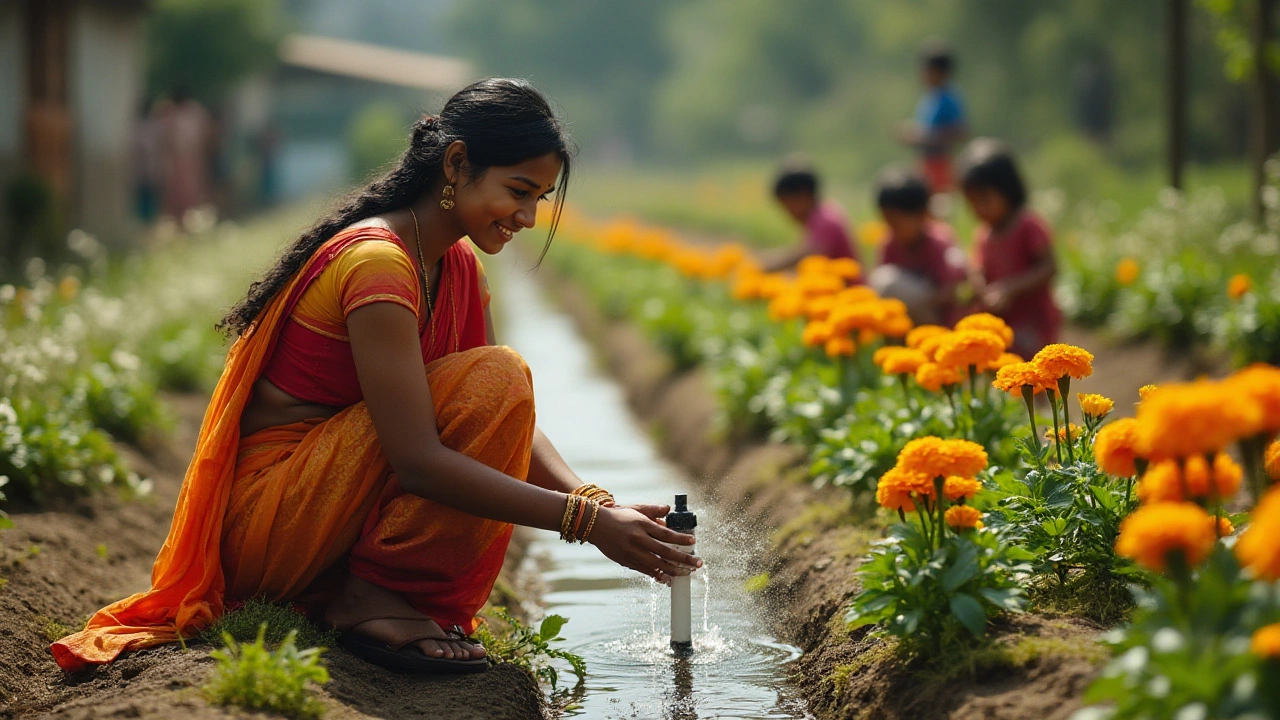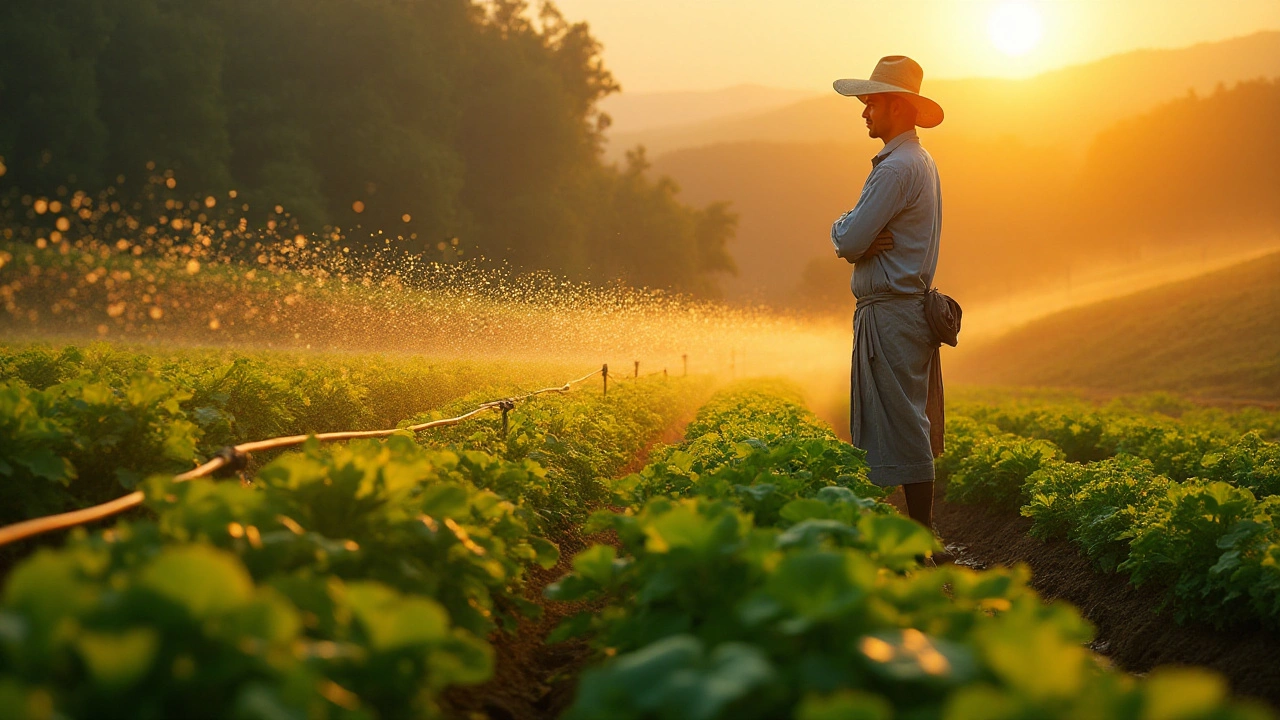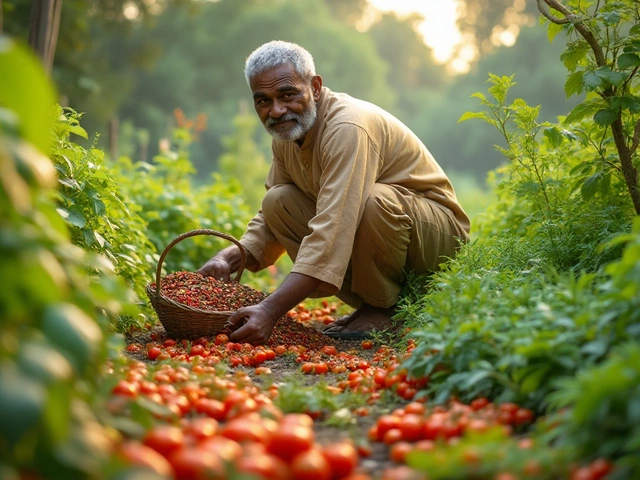Watering plants is one of those things that's simple yet vital for their survival and growth. The 30/30 rule is a handy guide in the world of drip irrigation, a method that gently delivers water right to the roots. This rule involves watering for 30 minutes, then resting for another 30, allowing the soil time to soak it all in without overwhelming the plants.
Drip irrigation shines especially in areas where water conservation is a key concern. But there's an art to it. By sticking to the 30/30 rule, you ensure the soil drinks deeply, encouraging roots to grow stronger and more resilient.
It’s not just a matter of setting and forgetting. Following this routine can minimize water loss while supporting robust plant growth. Understanding these principles is a small step that can make a big difference in your garden’s health.
- Understanding the 30/30 Rule
- How Drip Irrigation Works
- Benefits of Implementing the Rule
- Tips for Effective Water Management
- Common Mistakes and How to Avoid Them
Understanding the 30/30 Rule
The 30/30 rule is a splendid example of how simple guidelines can bring about profound changes in how we manage our water resources. This concept revolves around a straightforward yet powerful notion: water your plants for 30 minutes, then allow a 30-minute pause. This cycle allows the soil to absorb the water efficiently before the next torrent begins. What's surprising is how efficiently this rule can bolster the health of your plants, optimizing growth like never before.
Let's take a step back and delve into why this method is so impactful. When water is applied continuously, there's a risk that it simply runs off the surface, especially in clay-heavy soils. By breaking it down into manageable intervals, you're letting each drop soak into the earth, ensuring that there’s minimal waste. After the first 30 minutes, the break not only gives soil time to absorb the moisture but also to distribute it evenly around the root system, promoting healthier plant growth.
Scientific Foundations
Scientifically speaking, intermittent watering like the 30/30 rule supports better plant development. According to studies done by various agricultural universities, intermittent watering reduces water stress on plants, allowing them to uptake nutrients more efficiently. The rest periods allow the plant roots to breathe, preventing problems like root rot and salt accumulation. By promoting deeper root growth, plants can access nutrients in the deeper layers of soil, which leads to robust and vibrant plant life.
There's wisdom in this method that extends even to how certain human bodies work. Just as we optimize our energy by taking breaks after intense physical effort, plants also seem to thrive under cyclical watering schedules. It's akin to a well-timed tea break in the garden, not just for the gardener but for the plants themselves.
"Plants are remarkably adaptable creatures, able to thrive in a variety of conditions -- with the right amount of care and water." - Dr. Lina Arboretum, Professor of Botany
The drip irrigation systems can be meticulously adjusted to comply with this cycle, allowing for precision that other methods might lack. By sticking to this rule, the moisture level is kept at an optimal point, neither too dry nor drowning the plants in water. For arid climates especially, this strategy helps preserve every precious drop, ensuring sustainability and conservation of water resources.
| Benefits of 30/30 Rule | Description |
|---|---|
| Water Efficiency | Enhances absorption by minimizing runoff. |
| Healthy Roots | Promotes deeper root growth and nutrient uptake. |
| Prevents Diseases | Reduces risks like root rot and salt build-up. |
How Drip Irrigation Works
Drip irrigation operates on a beautifully simple yet efficient principle: delivering water directly to the plant's roots using a meticulously designed network of valves, pipes, tubing, and emitters. This system is indispensable for areas suffering from water scarcity or when trying to cultivate healthy, lush gardens with limited resources. Imagine an intricate web interconnecting every plant in your garden, ensuring that each receives precisely the amount of water it needs. By using a drip irrigation system, we can target the soil within this network, which means we're not wasting water on the surrounding dirt or air. This method isn't just effective—it's also environmentally responsible.
Water is introduced at a low rate, which might not seem like much, but over time, it combines efficiency and effectiveness. This slow, steady flow soaks deep into the soil, reaching the roots where it's needed most. The secret lies in maintaining consistent moisture levels around the roots. Water pressure plays a role in this process, with most systems functioning optimally between 20 and 25 psi, ensuring the emitters discharge water at a precise rate. These emitters, or drippers, come with various specifications, allowing you to select the right one based on individual plant needs.
“Optimizing water usage by directly targeting plant roots increases efficiency up to 90% compared to traditional watering methods,” says Dr. Harold Jenkins, a leading expert in sustainable agriculture.
An interesting technological advancement aiding this process is the inclusion of automated timers or moisture sensors. These devices can schedule watering times based on weather, soil content, and specific plant needs. Hence, the system eradicates the guesswork involved in manual watering. The installation may initially seem daunting, yet once in place, it requires little maintenance. Seasonal checks ensure that no particles block the drippers, keeping them in perfect working condition and making this irrigation method not just a convenience but a revolution in water conservation.
You'll find that some drip irrigation systems incorporate filtration systems, a crucial element in preventing clogs which could derail a system if debris finds its way in. It’s crucial to understand that with this irrigation method, you have the flexibility to tailor the system specific to your landscape and plant variety. Each plant is unique, meaning their watering requirements differ. A larger tree, for instance, will need more drippers compared to smaller, younger plants. This tailor-fit nature of drip irrigation dramatically helps in managing precious water resources, making it a vital component for watering efficiency and effective garden maintenance.

Benefits of Implementing the Rule
Embracing the 30/30 rule for drip irrigation brings with it a multitude of advantages, particularly for those passionate about sustainable gardening and farming practices. At its core, this method is about balance – striking the right rhythm between watering and resting periods that can ultimately lead to a more efficient use of water. One immediate benefit is the promotion of deep root growth. By encouraging the roots to chase after the moisture further down, plants develop a robust root system that’s invaluable, especially during drought periods. Deeper roots mean plants can reach for water reserves further from the surface, where water often evaporates quickly.
Another significant perk is water conservation. Given the uncertainty and scarcity of water in many parts of the world, optimizing water usage has never been more critical. With the drip irrigation method, we're delivering water directly to the plant's base, minimizing runoff and reducing evaporation, which is quite common with other methods like sprinklers. By adhering to the 30/30 timings, gardeners can potentially save a substantial amount of water, which not only supports the environment but also reduces utility bills.
A well-irrigated garden is a healthy garden. Consistent moisture levels created by this rule help prevent soil erosion and compaction. This is crucial because loose, nutrient-rich soil provides a haven for microorganisms that enrich the soil and improve plant health. It's a delicate dance but one that pays off by fostering a thriving micro-ecosystem beneath the surface. Healthy soil leads to better yields both in terms of quality and quantity.
One might ponder whether this method requires more planning, and while it's true that it takes some getting used to, once established, the 30/30 rhythm can become second nature. Many gardeners report feeling more in tune with the needs of their plants, as this rule encourages them to pay closer attention. As the saying goes, 'The best fertilizer is the gardener's shadow'. This principle encourages not just efficiency but also deeper engagement with the garden itself.
According to the Food and Agriculture Organization, efficient irrigation practices can increase crop yields by up to 25%, underscoring the potential impact of intelligent water management techniques.When you leverage the 30/30 rule, you also gain the benefit of fewer weeds. Since water is delivered straight to where it’s needed, rather than spread across broad areas, weed growth is often curtailed, reducing the need for weeding or chemical herbicides. This not only lightens the gardener's workload but also aligns with organic gardening practices that avoid chemical interventions.
Finally, consistent use of this method can lead to healthier, more vibrant gardens that are visibly more lush and productive. Gardens are living canvases, and using such methods ensures that you're creating something genuinely beautiful and sustainable. Adopting the 30/30 rule can transform a simple garden into a well-tuned ecosystem where plants flourish and water is used wisely – a win for gardeners and Mother Earth alike.
With these benefits in mind, the practical implementation of the 30/30 rule in drip irrigation systems goes beyond water conservation to usher in a new mindset of efficient resource use, creating an environment where both plants and the personal satisfaction of cultivating them can thrive.
Tips for Effective Water Management
Drip irrigation, as smart as it sounds, can be a game changer for those who wish to manage their water resources wisely. And let's face it, in the gardening world, there's no point in guessing when you can rely on some awesome tips. The first thing you should cling to is balance. Delivering a just-right amount of water ensures (*stronged*Drip Irrigation) works at its best, giving plants the moisture they need without drowning them in it. The magic here lies in understanding the needs of each plant; after all, they don’t all have the same preferred drink order! Consider setting a schedule and observe how your plants take to it, tweaking where necessary. Hydration should match your plant’s growth stages; seed germination might require different amounts compared to full-grown trees.
Nutrient delivery through irrigation is another feather in (*stronged*Your Drip System's) cap. The trick lies in timing your water application with the nutrient needs of your plants. At times, mixing nutrients in your water supply can serve a dual purpose, feeding and hydrating your flora. One can't overlook the role of maintenance in ensuring easy water flow. Regularly check your system pipes and emitters to make sure there's no clogs or leaks messing up your setup. Broken lines can lead to water wastage, pretty much cancelling out the system's efficiency. Speaking of pipes, make sure to lay them out in a way that maximizes reach and avoids evaporation due to sun exposure.
Keeping a log of your watering routine can help you identify patterns or anomalies that can impact plant growth. This log doesn’t just track water usage; it can reveal sneaky drought signs or the guilty rain showers that went unnoticed. So, hit the notebook like a detective. Want to involve science in your endeavor? Sensors can add sophistication to your watering game. These devices measure soil moisture, letting you know exactly when you need to water. Think of them as the Waze for plants, navigating your crop through uncharted drought and flood territories. Keeping technology involved can take away the hassle of manually inspecting each plant.
Dr. Edward White, a plant ecology professor, once noted, "Understanding the relationship between plant physiology and water usage can turn amateur gardeners into expert cultivators."
And don’t forget the environment! Opting for a re-circulated water system can save gallons, and even rainwater harvesting could complement your drip irrigation to a significant degree. A tested method, rain barrels can act as a reservoir full of 'free' water. When the sky showers blessings over your area, you should be armed with collection bins ready to fill. In your quest for efficient water management, integrating (*stronged*The 30/30 Rule) with these ideas might just transform your garden. Every precious drop gets a purpose, every plant its share, and Mother Earth a little relief from overuse.
Check out this simple guide to setting up your rainwater system:
- Choose a flat surface for your barrel placement.
- Position it under a downspout diverter from your roof.
- Ensure the barrel has a secure lid and bottom tap for seamless collection and usage.
- Connect your (*stronged*Drip Irrigation) hoses to evenly distribute the collected rainwater.
- Regularly clean to avoid mosquito breeding.
These small steps can lead to significant transformations, all aimed at achieving that dreamy, self-sufficient *stronged*Watering Efficiency that all of us gardening enthusiasts talk about during coffee breaks!

Common Mistakes and How to Avoid Them
Adopting the 30/30 rule in drip irrigation is a smart move, but like any system, it's not immune to errors. One common mistake involves improper setup of the irrigation system. Many enthusiasts rush the installation, missing out on critical checks like ensuring even water pressure throughout the system. This can result in some plants receiving too much water while others remain parched. The best way to tackle this is by using pressure regulators and emitters that match the water flow needs of your garden. Ensuring that all the components are compatible will maintain a balanced setup.
Another frequent error is neglecting to adapt the schedule for seasonal changes. While the 30/30 rule sets a solid foundation, different seasons call for adjustments. During hot summer days, water evaporation rates increase, necessitating slightly longer cycles. Conversely, wet winter months might require watering less than the usual frequency. Monitoring moisture levels in the soil can offer valuable insights that help adjust watering patterns accordingly, maintaining plant health year-round.
Sometimes, even the most knowledgeable gardeners overlook the need for regular maintenance. Debris, mineral buildup, and blockages can occur over time, disrupting the delivery of water. Regularly checking and cleaning the system components can prevent these issues. Additionally, taking the time to walk through your garden to inspect the health of your plants offers a real-time assessment of the system’s effectiveness. Address any dry patches or waterlogged areas promptly to ensure your system is running at full efficiency.
A classic mistake is using one-size-fits-all emitters on every plant. Different plants have varying water needs. It's crucial to customize emitters to suit each plant species in your garden to optimize water usage. For instance, vegetable plants generally have higher water demands compared to succulents. Customizing your emitter setup ensures every plant receives exactly the right amount of hydration, promoting vigorous growth.
"Every drop of water we save is a step towards a sustainable future," notes environmental advocate Jane Goodall. Her wisdom underlines the importance not just of conservation, but of effective and mindful watering practices, pivotal in drip irrigation.Lastly, not embracing technological advancements can limit the potential of your irrigation efforts. Modern irrigation systems come equipped with smart controllers and sensors that automate the watering process based on weather forecasts and soil moisture readings. Investing in these can save time and ensure precise water delivery, aligning perfectly with nature’s needs. Leveraging technology enhances efficiency, making the 30/30 rule even more effective.





